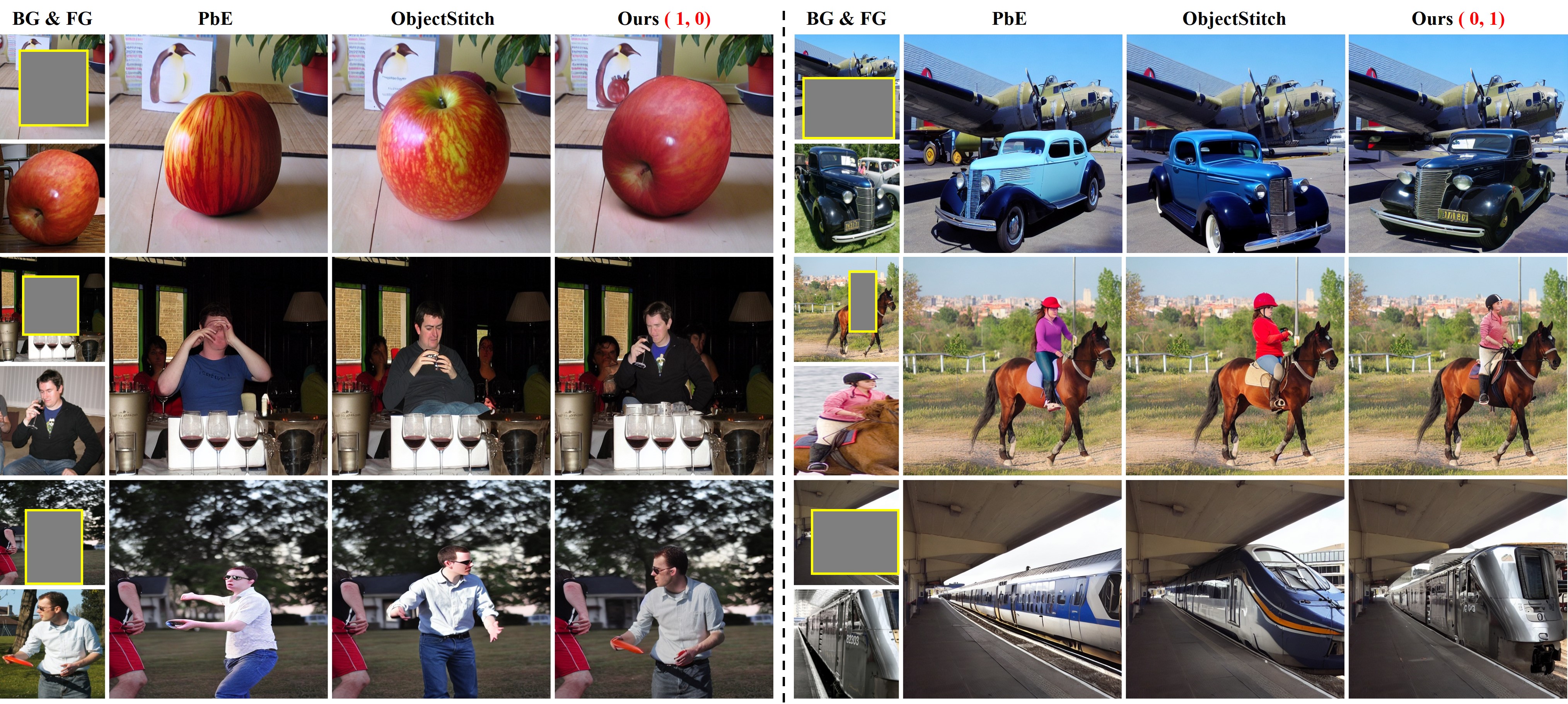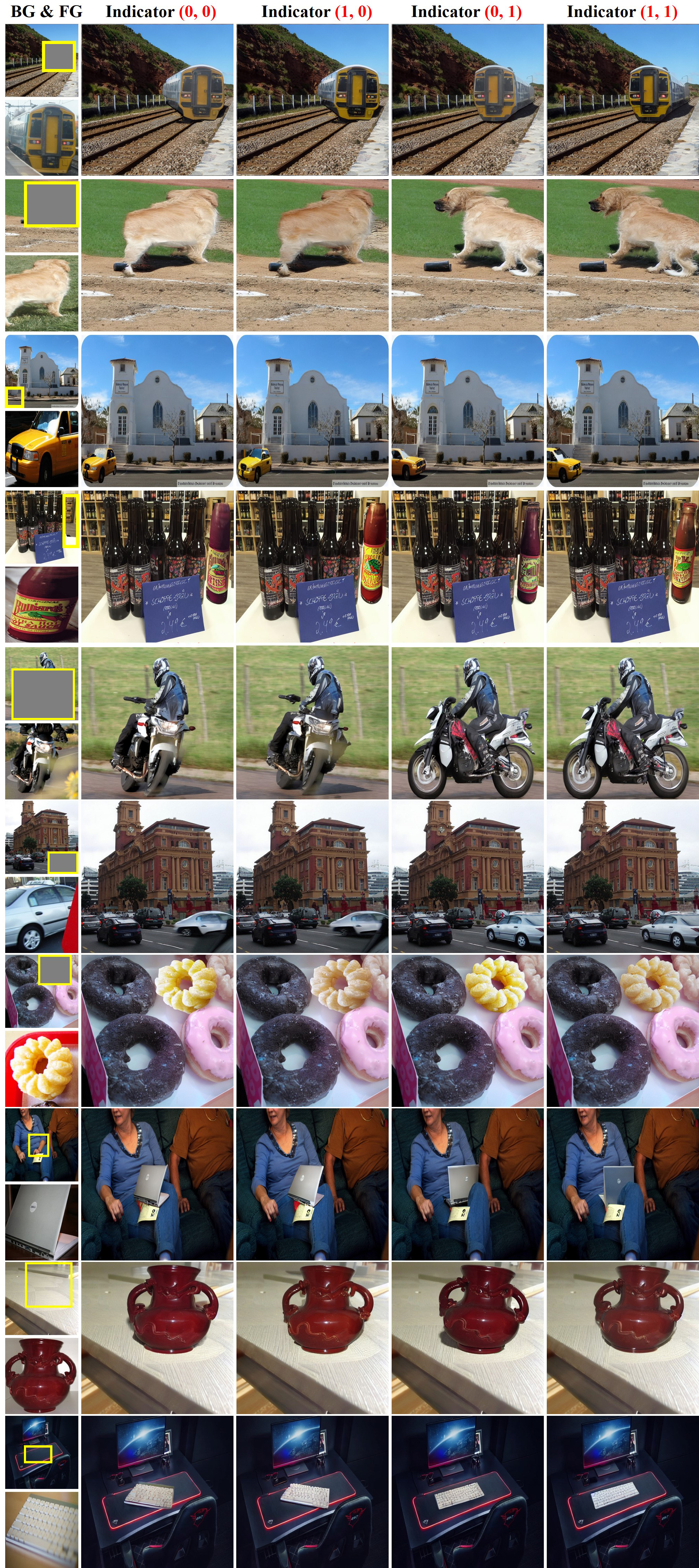This is the official repository for the following research paper:
ControlCom: Controllable Image Composition using Diffusion Model [arXiv]
Bo Zhang, Yuxuan Duan, Jun Lan, Yan Hong, Huijia Zhu, Weiqiang Wang, Li Niu
Part of our ControlCom has been integrated into our image composition toolbox libcom https://github.com/bcmi/libcom. Welcome to visit and try \(^▽^)/
The online demo of image composition can be found here.
In our controllable image composition model, we unify four tasks in one model using an 2-dim binary indicator vector, in which the first (resp., second) dimension represents whether adjusting the foreground illumination (resp., pose) to be compatible with background. 1 means making adjustment and 0 means remaining the same. Therefore, (0,0) corresponds to image blending, (1,0) corresponds to image harmonization, (0,1) corresponds to view synthesis, (1,1) corresponds to generative composition.
Our method can selectively adjust partial foreground attributes. Previous methods may adjust the foreground color/pose unexpectedly and even unreasonably, even when the foreground illumination and pose are already compatible with the background. In the left part, the foreground pose is already compatible with background and previous methods make unnecessary adjustment. In the right part, the foreground illumination is already compatible with the background and previous methods adjust the foreground color in an undesirable manner.
The (0,0), (1,0) versions without changing foreground pose are very robust and generally well-behaved, but some tiny details may be lost or altered. The (0,1), (1,1) versions changing foreground pose are less robust and may produce the results with distorted structures or noticeable artifacts. For foreground pose variation, we recommend more robust ObjectStitch.
Our method is built upon stable diffusion and the network architecture is shown as follows.
- Download link:
- Description:
- This dataset is built upon the existing Foreground Object Search dataset.
- Each background image within this dataset comes with a manually annotated bounding box. These bounding boxes are suitable for placing one object from a specified category.
- The resultant dataset consists of 640 pairs of backgrounds and foregrounds. This dataset is utilized in our user study and qualitative comparison.
-
Python == 3.8.5
-
Pytorch == 1.10.1
-
Pytorch-lightning == 1.9.0
-
Run
cd ControlCom-Image-Composition pip install -r requirements.txt cd src/taming-transformers pip install -e .
-
Please download the following files to the
checkpointsfolder to create the following file tree:checkpoints/ ├── ControlCom_blend_harm.pth ├── ControlCom_view_comp.pth └── openai-clip-vit-large-patch14 ├── config.json ├── merges.txt ├── preprocessor_config.json ├── pytorch_model.bin ├── tokenizer_config.json ├── tokenizer.json └── vocab.json -
openai-clip-vit-large-patch14 (Huggingface | ModelScope): The foreground encoder of our ControlCom is built on pretrained clip.
-
ControlCom_blend_harm.pth (Huggingface | ModelScope): This model is finetuned for 20 epochs specifically for the tasks of image blending and harmonization. Therefore, when the
taskargument is set to "blending" or "harmonization" in the following test code, this checkpoint will be loaded. -
ControlCom_view_comp.pth (Huggingface | ModelScope): This model is enhanced on viewpoint transformation through finetuning for several epochs using additional multi-viewpoint datasets, i.e., MVImgNet. When the
taskargument is set to "viewsynthesis" or "composition" in the following test code, this checkpoint will be loaded.
-
To perform image composition using our model, you can use
scripts/inference.py. For example,python scripts/inference.py \ --task harmonization \ --outdir results \ --testdir examples \ --num_samples 1 \ --sample_steps 50 \ --gpu 0or simply run:
sh test.sh
These images under examples folder are obtained from COCOEE dataset.
- Please refer to the examples folder for data preparation:
- keep the same filenames for each pair of data.
- either the
mask_bboxfolder or thebboxfolder is sufficient. foreground_maskfolder is optional but recommended for better composite results.
- Download link:
Notes: certain sensitive information has been removed since the model training was conducted within a company. To start training, you'll need to prepare your own training data and make necessary modifications to the code according to your requirements.
We show our results using four types of indicators.
The quantitative results and evaluation code can be found here.
This code borrows heavily from Paint-By-Example. We also appreciate the contributions of Stable Diffusion.
If you find this work or code is helpful in your research, please cite:
@article{zhang2023controlcom,
title={Controlcom: Controllable image composition using diffusion model},
author={Zhang, Bo and Duan, Yuxuan and Lan, Jun and Hong, Yan and Zhu, Huijia and Wang, Weiqiang and Niu, Li},
journal={arXiv preprint arXiv:2308.10040},
year={2023}
}
- We summarize the papers and codes of generative image composition: Awesome-Generative-Image-Composition
- We summarize the papers and codes of image composition from all aspects: Awesome-Image-Composition
- We summarize all possible evaluation metrics to evaluate the quality of composite images: Composite-Image-Evaluation
- We write a comprehensive survey on image composition: the latest version



